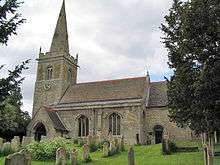Saint Gildard
Saint Gildard or Gildardus, or Gildaredus[2] also known as Saint Godard or Godardus (c. 448 – c. 525), was the Bishop of Rouen from 488 to 525. He is venerated as a saint of the Roman Catholic Church, and the missal of the Sarum Rite refers to him as a confessor.[1]
Saint Gildard | |
|---|---|
| Bishop and Confessor | |
| Born | c. 448 |
| Died | c. 525 Rouen, Normandy, France |
| Venerated in | Roman Catholic Church |
| Major shrine | Abbey of St. Medard, Soissons |
| Feast | June 8[1] |
Life
Earlier versions of the Roman Martyrology contend that he was the twin brother of Saint Medard—that they were born on the same day, were consecrated bishop on the same day, and died on the same day. However, in 511 Gildard attended the First Council of Orléans, convoked by Clovis I; only in 530 was Medard consecrated. He is commemorated in Rouen, with his supposed brother.[3] Alban Butler adds that he "governed the see of Rouen with great zeal during the space of fifteen years."[4]
His body was buried at St. Mary's Church in Rouen, which later was named after him.[3] According to Butler, his body was removed during Norman incursions and moved to the Abbey of St. Medard in Soissons, where it remains.[4]
Cult

That Gildard is venerated in the first place is due to the association with Medard, according to Felice Lifshitz. No cult was promoted and his relics, kept in Notre Dame (St. Mary) in suburban Rouen, languished. They were removed to the Abbey of St. Medard in Soissons precisely because of the supposed sibling connection; when the monks of St. Medard discovered this link, they argued successfully with Charles the Bald that the brothers be reunited in death.[5] Apparently the people of Rouen were not happy to see their saint go, and made the offer that the monks of St. Medard leave them the head of Gildard, for which they would give them the head of Saint Romanus of Rouen, one of their bishops, or the entire body of Remigius of Rouen, their third archbishop.[6] In Soissons, Gildard "was provided for the first time with literary traditions and [here] his cult was promoted."[5]
Churches named for Medard and Gildard
- Church of Saint-Médard-et-Saint-Gildard, in Crépon, Calvados, France; 12th–14th century.
- Church of Saint-Médard-et-Saint-Gildard, in Fel, Orne, France;[7] 12th century (today only Saint-Médard, apparently).
- Church of St Medard and St Gildard, parish church in Little Bytham, Lincolnshire, England; dating back to Anglo-Saxon period.
References
- The Sarum Missal: In English. Church Press Company. 1868. pp. 372.
- Gildaredus took part in the First Council of Orléans in 511. C. De Clercq, Concilia Galliae, A. 511 – 695 (Turnhout: Brepols 1963), p. 13 and 14 (Geldaredus), 15 and 16 (Gildaredus, and Gildardus), 17 (Gelidandus), 19 (Gildaredus).
- Smith, William; Wace, Henry (1880). A Dictionary of Christian Biography, Literature, Sects and Doctrines, Being a Continuation of "The Dictionary of the Bible": Eaba-Hermocrates. J. Murray. p. 669. Retrieved 30 December 2010.
- Butler, Alban (1821). The lives of the fathers, martyrs, and other principal saints. p. 127.
- Lifshitz, Felice (1990). "Eight Men In: Rouennais Traditions of Archiepiscopal Sanctity". Haskins Society Journal Studies in Medieval History. Continuum. pp. 63–82 [66]. ISBN 978-1-85285-059-3. Retrieved 30 December 2010.
- Lifshitz, Felice (1995). The Norman conquest of Pious Neustria: historiographic discourse and saintly relics, 684–1090. PIMS. p. 117. ISBN 978-0-88844-122-5.
- Thomas Duffus Hardy, Rotuli Normanniae in turri Londinensi asservati, Johanne et Henrico quinto Angliæ regibus, vol. I (1200–1205, 1417), London, 1835, p. 344 : paroch[ia] S[an]c[t]o[rum] Medardi et Gildardi de Felle in 1417.